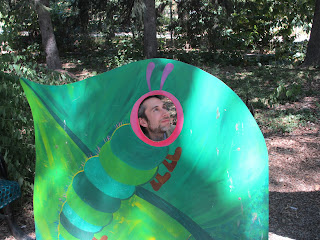This first appeared in the July issue of a
regional paper, but people keep reporting link errors, so here it is to hopefully a wider audience. Now you really know what I think about lawns.
Finally, it’s the weekend. Lazy mornings where the fog of a long
sleep creeps delightfully into every waking observation—the robins
feeding their young at the nest, bees hopping from coreopsis to
coneflower, the cool breeze before a suddenly warm afternoon. And the
belching vibration of the neighbor’s lawnmower along the fence, the
sweet exhaust stinging one’s throat on the retreat back inside.
It is impossible to have coffee on the deck or to be heard in casual
conversation on most any summer evening or weekend. I have a neighbor
who mows three times a week, tossing nutrient-rich clippings, one-third
of a lawn’s needed amount, into the trash; and yet the perfect lines
this neighbor leaves of “cut” grass do not seem any lower than those of
the uncut. Another neighbor clearly prefers to mow less often—he
scalps the yard once a week so it turns brown, then sprinklers come out
a few days later, usually on a hot and windy late afternoon,
evaporating long before the water hits the roots. Why doesn’t he leave
the lawn at 3 inches in height and save on the water bill and time
moving hoses?
Each weekend 54 million lawns are mowed, together equivalent to the
size of Virginia, using up 800 million gallons of gas (17 million lost
due to spills). All kinds of cancer-causing, asthma-irritating,
blood-flow constricting, sperm-killing compounds are inhaled by the
person pushing the mower. In California lawn equipment accounts for 10
percent of the air pollution, pollution that is equivalent to over one
hour of driving 10 to 43 new cars (estimates vary) hundreds of miles
over the same amount of time. Mowers also run at 90 to 95 decibels, the
same level as a Harley. Anything over 85 decibels creates temporary or
permanent hearing loss.
So, fine, lawnmowers are the scourge of suburbia, the hope of our
mini kingdoms to serve as quiet and sheltered acreages away from the
stress of work and school. But what about other tools we use to create
and maintain our lawns? Chemical companies have us believing we need to
fertilize our lawns four times a year with nitrogen-laden products;
the excess nitrogen that lawns can’t use turns into a powerful
greenhouse gas, and much of it leaches into groundwater and storm
drains, polluting and choking aquatic life. Take a look at the dead
zone near the Mississippi delta and in our farm ponds. Artificial
nitrogen also sets up a cycle of lawn dependency like a drug addict—the
soil life dies, and the lawn needs more juice, so you fertilize and
mow and water more often. Don’t forget about the process to produce all
that fertilizer—an energy-intensive ordeal that releases many
greenhouse gases as a result.
The argument will always be that we need lawns for kids and pets to
play in. But trust me—you don’t want your kids running barefoot in a
lawn slathered and sprayed in who knows what. Of 30 commonly used lawn
pesticides, for example, 19 are linked to cancer, 13 to birth defects,
21 to reproductive effects, 26 to liver and kidney damage and 15 to
neurotoxicity (brain development). Twenty-four of these pesticides are
toxic to fish, 11 to bees and 16 to birds. And what about cost? An acre
of lawn at a church, apartment complex or industrial park over 20
years will cost roughly $20,000 to maintain—whereas the same acre in
native vegetation will cost $3,000. Why don’t we see more native
vegetation at our workplaces? Why don’t churches and community centers,
especially, take a lead in this? And schools? Students who interact
with nature are proven to have higher creative and cognitive skills,
and children with Attention Deficit Disorder show astounding
improvement.
Have some lawn, but border it with relatively low-maintenance native
shrubs and wildflowers. Have some lawn, but don’t use inorganic
chemicals or even any chemicals at all—top-dress it with one-quarter
inch of free city compost, like LinGro in Lincoln. Let those prairie
flower and shrub roots amend the soil underneath and create thriving,
self-sustaining ecosystems that provide free nutrients and filter our
groundwater. Think about using an electric mower, which runs at 70
decibels and costs $5 a year to operate, or the innovative Fiskars reel
mowers.
Our backyards are nature preserves—for the birds and bees, and for
our children and ourselves. As native ecosystems lose their ability to
sustain themselves, through habitat loss and chemical overspray, we can
create environments that physically and emotionally sustain ourselves
(and other species) with less effort than we give our landscapes now.
If anything, think about how good that morning coffee will taste when
you’re mowing less and your kids are following a monarch from
coneflower to coneflower and across the naturally green lawn. You might
even be able to hear the hummingbird at a penstemon.

















